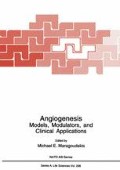Abstract
Healing wounds provide a unique opportunity to study angiogenesis. Ever since the development of multicellular organisms necessitated the development of a circulatory system, injury has been a common feature of life. In all likelihood repair and replacement of injured vessels occured simultaneously with the original processes by which blood vessels developed in evolution. It is difficult even to imagine that reparative angiogenesis differs in any material way from that which occurs in normal growth and development; or, for that matter, from angiogenesis in many tumors. Wound angiogenesis is also extremely rapid and is unencumbered by the irrelevant, often distracting properties of tumors. Furthermore, wound healing presents a unique and liberating methodological opportunity because the artifact of the measurement, the wound, is the object of the exercise. Finally, the wound environment is easily measured and duplicated and intercellular messengers are easily sampled. With respect to oxygen, for instance, wounds are hypoxic and hyperlactated by nature1,2. This was found simply by aspirating and measuring the fluid which ordinarily collects in wounds2. Furthermore, oxygen tension, lactate levels and numerous other characteristics are easily influenced and measured experimentally.
Access this chapter
Tax calculation will be finalised at checkout
Purchases are for personal use only
Preview
Unable to display preview. Download preview PDF.
References
Constant, J. MD., Suh, D. MD., Hussain, M. PhD., Hunt, T. MD. Wound Healing Angiogenesis: The Metabolic Basis of Repair. In: Mol, Cell, Clin Aspects of Angiogenesis. 1996. New York. Plenum Press; 151–159.
Hunt TK, Conolly WB, Aronson SB, Goldstien P. Anaerobic metabolism and wound healing: An Hypothesis for the initiation and cessation of collagen synthesis in wounds. Am J Surg. 1978, 135:328–332.
Hunt TK. “The Physiology of Wound Healing.” Ann of Emerg. Med. 1988; 17.1265–1273.
Hunt TK, Pai MP. The effect of varying ambient oxygen tensions on wound metabolism and collagen synthesis. Surg Gynecol Obstet. 1972;135:561–567.
Farrara N, Davis-Smyth T. The biology of vascular endothelial growth factor. Endocrine Reviews. 1997; 18(l):4–25.
Newsholme P., Costa Rosa LFP, Newsholme E., Curi R. The importance of fuel metabolism to macrophage function. Cell Biochem and Function 1996;14:1–10.
Hussain MZ, Ghani QP, Hunt TK. Inhibition of prolyl hydorxylase by poly [ADP-ribose] and phosphoribosyl-AMP. Possible role of ADP ribosylation in intracellular prolyl hydroxylase regulation. J Biol Chem. 1989;264; 14:7850–5.
Satoh MS, Lindahl T. Role of Poly[ADP-ribose] formation in DNA repair. Nat. 1992;356:356–358.
Ghani QP, Hussain MZ, Zhang J, Hunt TK. Control of procollagen gene transcription and prolyl hydorxylase activity by poly[ADP-ribose]. G Poirier and A Moreaer (eds). In: ADP-Ribosylation Reactions. 1992. New York. Springer Verlag 111–117.
Koch AE; Cho M; Burrows JC; Polverini PJ; Leibovich SJ. Inhibition of production of monocyte/macrophage-derived angiogenic activity by oxygen free-radical scavengers. Cell Biology International Reports, 1992 May, 16(5):415–25.
Eyre, D.R., Paz, M.A., Gallop, P.M. Cross-linking in collagen and elastin. Annu. Rev. Biochem. 1984. 53:717–748.
Jonsson K, Jensen JA, Goodson WH, Scheuenstuhl H, West J, Hopf H, Hunt TK. Tissue oxygenation, anemia and perfusion in relation to wound healing in surgical patients. Annals of Surg, 1991 214:605–613.
Berger NA. Poly[ADP-ribose] in the cellular response to DNA damage. Rad. Res. 1985;101:4–15.
Satoh MS, Poirier GG, Lindahl T. NAD+-dependent repair of damaged DNA by human cell extracts. J. Biol Chem. 1993;268:5480–5487.
Winkler J; Cochran F. Apoptosis: insight into its role in inflammation. Inflammation research, 1997 Jan, 46(1):3
Author information
Authors and Affiliations
Editor information
Editors and Affiliations
Rights and permissions
Copyright information
© 1998 Springer Science+Business Media New York
About this chapter
Cite this chapter
Gibson, J.J., Hunt, T.K., Feng, J.J., Rollins, M.D., Sheikh, A.Y., Hussain, M.Z. (1998). The Several Roles for Oxygen in Wound Angiogenesis. In: Maragoudakis, M.E. (eds) Angiogenesis. NATO ASI Series, vol 298. Springer, Boston, MA. https://doi.org/10.1007/978-1-4757-9185-3_11
Download citation
DOI: https://doi.org/10.1007/978-1-4757-9185-3_11
Publisher Name: Springer, Boston, MA
Print ISBN: 978-1-4757-9187-7
Online ISBN: 978-1-4757-9185-3
eBook Packages: Springer Book Archive

